Kalmar Castle Sweden

Once a formidable fortress, the castle was converted to a magnificent Renaissance palace.
Photo by Maria Eklind
Kalmar Castle, located in the province of Småland, Sweden, is an imposing fortress with a storied history dating back to the 12th century. Initially constructed as a defensive structure to protect the southern Swedish coast, the castle underwent several renovations and expansions over the centuries, evolving from a medieval stronghold into a Renaissance palace.
One of the most significant events in Kalmar Castle's history occurred in 1397 when it served as the venue for the signing of the Kalmar Union, a political union between Denmark, Norway, and Sweden. This union aimed to establish peace and cooperation among the Scandinavian kingdoms and lasted until the early 16th century.
During the reign of King Gustav Vasa in the 16th century, Kalmar Castle was converted into a magnificent Renaissance palace. The castle's architectural features, including its impressive towers, ornate façades, and grand halls, reflected the wealth and power of the Swedish monarchy during this period.
Throughout its history, Kalmar Castle played an important role in Sweden's defense strategy, serving as a military stronghold and a symbol of royal authority. It witnessed numerous sieges and battles, including conflicts with Denmark and rebellions against Swedish monarchs, yet it remained a formidable fortress.
In the 19th century, Kalmar Castle underwent significant restoration efforts to preserve its architectural heritage and historical significance. Today, the castle stands as one of Sweden's most iconic landmarks, attracting visitors from around the world who come to admire its medieval and Renaissance architecture, explore its rich history, and enjoy panoramic views of the Baltic Sea from its towers.
Kalmar Castle serves as a cultural center, hosting exhibitions, concerts, and events that celebrate Sweden's heritage and traditions. Its well-preserved chambers, including the royal apartments, banquet halls, and armory, offer visitors a glimpse into the life of Swedish royalty and nobility during the medieval and Renaissance periods.
Source ChatGPT
Who was King Gustav Vasa?
King Gustav Vasa, born Gustav Eriksson, was a pivotal figure in Swedish history. He led the Swedish War of Liberation against the forces of Christian II of Denmark and the Kalmar Union, ultimately securing Swedish independence and establishing the Vasa dynasty as rulers of Sweden.
Gustav Vasa ascended to the throne in 1523 after successfully ousting the Danish forces and was crowned King of Sweden. His reign marked the beginning of the Swedish Renaissance and the consolidation of royal power.
Gustav Vasa implemented numerous reforms, including the establishment of the Lutheran Church, centralization of government administration, and promotion of education and trade. He is often credited with laying the foundations for modern Sweden and is remembered as one of the country's most influential monarchs.
What was the Kalmar Union?
The Kalmar Union was a political union between the kingdoms of Denmark, Norway, and Sweden, established in 1397 under the reign of Queen Margaret I of Denmark. The union aimed to consolidate the power of the Scandinavian kingdoms and ensure stability in the region. It was named after the city of Kalmar in Sweden, where the agreement was signed.
The Kalmar Union lasted until 1523 when Sweden declared independence, marking the end of the union.





